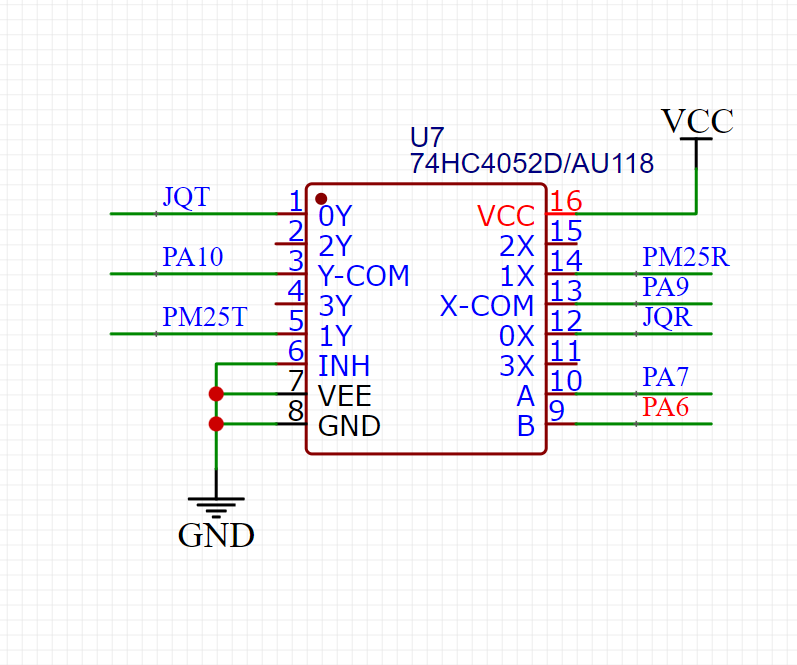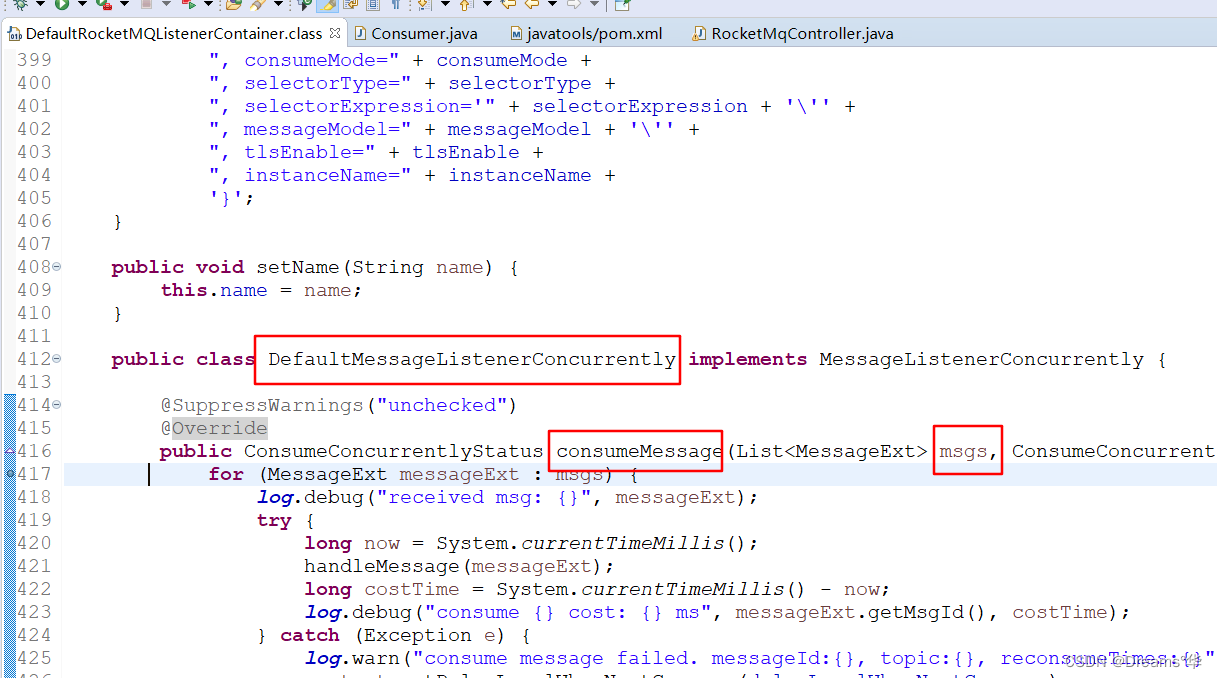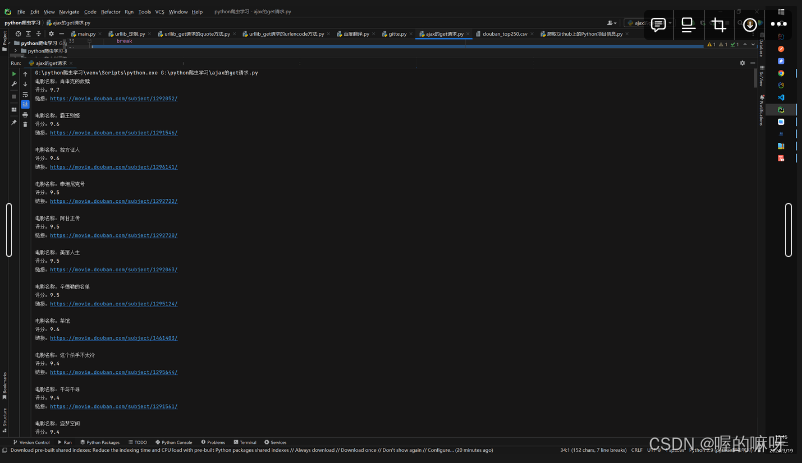主页:醋溜马桶圈-CSDN博客
专栏:c++_醋溜马桶圈的博客-CSDN博客
gitee:mnxcc (mnxcc) - Gitee.com
目录
1. list的介绍及使用
1.1 list的介绍
1.2 list的使用
1.2.1 list的构造
1.2.2 list iterator的使用
1.2.3 list capacity
1.2.4 list element access
1.2.5 list modifiers
1.2.6 list的迭代器失效
2. list的深度剖析及模拟实现
2.1 模拟实现list
2.2 list的反向迭代器
3. list与vector的对比
3.1 list与vector的对比
3.2 对比list排序和vector排序
1. list的介绍及使用
1.1 list的介绍
list - C++ Reference (cplusplus.com)
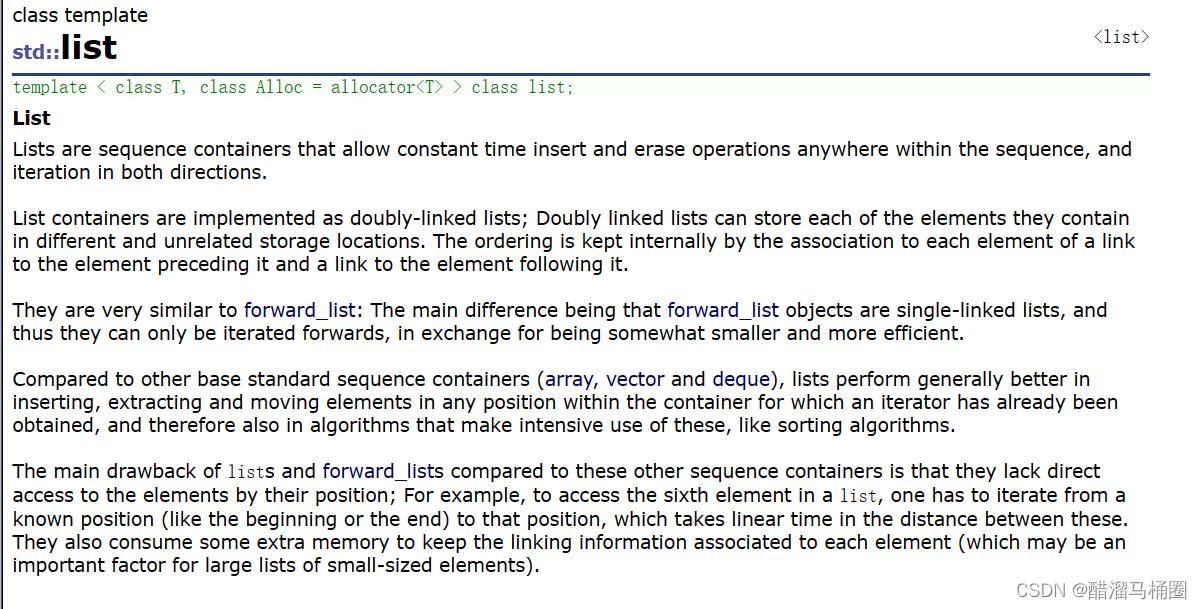
- list是可以在常数范围内在任意位置进行插入和删除的序列式容器,并且该容器可以前后双向迭代
- list的底层是双向链表结构,双向链表中每个元素存储在互不相关的独立节点中,在节点中通过指针指向其前一个元素和后一个元素
- list与forward_list非常相似:最主要的不同在于forward_list是单链表,只能朝前迭代,已让其更简单高效
- 与其他的序列式容器相比(array,vector,deque),list通常在任意位置进行插入、移除元素的执行效率更好
- 与其他序列式容器相比,list和forward_list最大的缺陷是不支持任意位置的随机访问,比如:要访问list的第6个元素,必须从已知的位置(比如头部或者尾部)迭代到该位置,在这段位置上迭代需要线性的时间开销;list还需要一些额外的空间,以保存每个节点的相关联信息(对于存储类型较小元素的大list来说这可能是一个重要的因素)

1.2 list的使用
list中的接口比较多,此处类似,只需要掌握如何正确的使用,然后再去深入研究背后的原理,已达到可扩展的能力。以下为list中一些常见的重要接口
1.2.1 list的构造

1.2.2 list iterator的使用
此处,大家可暂时将迭代器理解成一个指针,该指针指向list中的某个节点


【注意】
- begin与end为正向迭代器,对迭代器执行++操作,迭代器向后移动
- rbegin(end)与rend(begin)为反向迭代器,对迭代器执行++操作,迭代器向前移动
1.2.3 list capacity

1.2.4 list element access

1.2.5 list modifiers
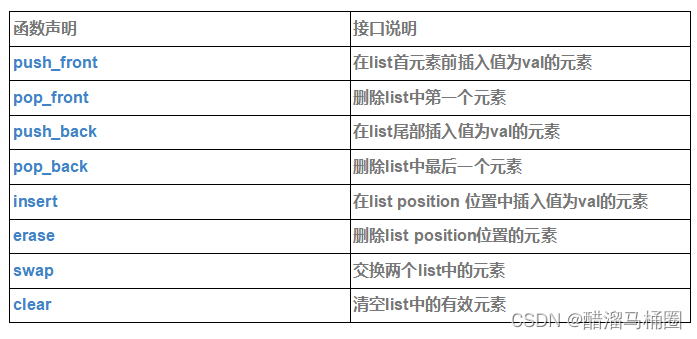
list<int> lt;lt.push_back(1);lt.push_back(2);lt.push_back(3);lt.push_back(4);lt.push_back(4);lt.push_back(4);lt.push_back(4);1.2.6 list的迭代器失效
前面说过,此处大家可将迭代器暂时理解成类似于指针,迭代器失效即迭代器所指向的节点的无效,即该节点被删除了。因为list的底层结构为带头结点的双向循环链表,因此在list中进行插入时是不会导致list的迭代器失效的,只有在删除时才会失效,并且失效的只是指向被删除节点的迭代器,其他迭代器不会受到影响
2. list的深度剖析及模拟实现
2.1 模拟实现list
#pragma once
#include <assert.h>
#include <iostream>
using namespace std;namespace dc
{template<class T>struct ListNode{ListNode<T>* _next;ListNode<T>* _prev;T _data;ListNode(const T& x=T()):_next(nullptr),_prev(nullptr),_data(x){}};//typedef ListIterator<T, T&, T*> iterator;//typedef ListIterator<T, const T&, const T*> const_iterator;template<class T,class Ref,class Ptr>struct ListIterator{typedef ListNode<T> Node;typedef ListIterator<T, Ref, Ptr> Self;Node* _node;ListIterator(Node* node):_node(node){}//*it//T& operator*()Ref operator*(){return _node->_data;}//it->//T* operator->()Ptr operator->(){return &_node->_data;}//++itSelf& operator++(){_node = _node->_next;return *this;}//it++Self operator++(int){Self tmp(*this);_node = _node->_next;return tmp;}//--itSelf& operator--(){_node = _node->_prev;return *this;}//it--Self operator--(int){Self tmp(*this);_node = _node->_prev;return tmp;}bool operator!=(const Self& it){return _node != it._node;} bool operator==(const Self& it){return _node == it._node;}};//template<class T>//struct ListConstIterator//{// typedef ListNode<T> Node;// typedef ListConstIterator<T> Self;// Node* _node;// ListConstIterator(Node* node)// :_node(node)// {}// //*it// const T& operator*()// {// return _node->_data;// }// //it->// const T* operator->()// {// return &_node->_data;// }// //++it// Self& operator++()// {// _node = _node->_next;// return *this;// }// //it++// Self operator++(int)// {// Self tmp(*this);// _node = _node->_next;// return tmp;// }// //--it// Self& operator--()// {// _node = _node->_prev;// return *this;// }// //it--// Self operator--(int)// {// Self tmp(*this);// _node = _node->_prev;// return tmp;// }// bool operator!=(const Self& it)// {// return _node != it._node;// }// bool operator==(const Self& it)// {// return _node == it._node;// }//};template<class T>class list{typedef ListNode<T> Node;public://typedef ListIterator<T> iterator;//typedef ListConstIterator<T> const_iterator;typedef ListIterator<T, T&, T*> iterator;typedef ListIterator<T, const T&, const T*> const_iterator;iterator begin(){//return _head->_next;return _head->_next;}iterator end(){return _head;}const_iterator begin() const{//return _head->_next;return _head->_next;}const_iterator end() const{return _head;}//初始化头结点void empty_init(){_head = new Node;_head->_next = _head;_head->_prev = _head;_size = 0;}list(){empty_init();}//lt2(lt1)list(const list<T>& lt){empty_init();for (auto& e : lt){push_back(e);}}//需要析构,一般就需要自己写深拷贝//不需要析构,默认浅拷贝就可以void swap(list<T>& lt){std::swap(_head, lt._head);std::swap(_size, lt._size);}//lt1=lt3list<T>& operator=(list<T> lt){swap(lt);return *this;}void clear(){iterator it = begin();while (it != end()){it = erase(it);}}~list(){clear();delete _head;_head = nullptr;}//void push_back(const T& x)//{// Node* newnode = new Node(x);// Node* tail = _head->_prev;// tail->_next = newnode;// newnode->_prev = tail;// _head->_prev = newnode;// newnode->_next = _head;//}void push_back(const T& x){insert(end(), x);}void push_front(const T& x){insert(begin(), x);}void pop_back(){erase(--end());}void pop_front(){erase(begin());}void insert(iterator pos, const T& val){Node* cur = pos._node;Node* newnode = new Node(val);Node* prev = cur->_prev;prev->_next = newnode;newnode->_next = cur;cur->_prev = newnode;newnode->_prev = prev;_size++;}iterator erase(iterator pos){Node* cur = pos._node;Node* prev = cur->_prev;Node* next = cur->_next;prev->_next = next;next->_prev = prev;delete cur;_size--;return iterator(next);}size_t size() const{return _size;}bool empty(){return _size == 0;}private:Node* _head;size_t _size;};
}2.2 list的反向迭代器
通过前面例子知道,反向迭代器的++就是正向迭代器的--,反向迭代器的--就是正向迭代器的++,因此反向迭代器的实现可以借助正向迭代器,即:反向迭代器内部可以包含一个正向迭代器,对正向迭代器的接口进行包装即可
template<class Iterator>
class ReverseListIterator
{// 注意:此处typename的作用是明确告诉编译器,Ref是Iterator类中的类型,而不是静态成员变量// 否则编译器编译时就不知道Ref是Iterator中的类型还是静态成员变量// 因为静态成员变量也是按照 类名::静态成员变量名 的方式访问的
public:typedef typename Iterator::Ref Ref;typedef typename Iterator::Ptr Ptr;typedef ReverseListIterator<Iterator> Self;
public://// 构造ReverseListIterator(Iterator it) : _it(it) {}//// 具有指针类似行为Ref operator*() {Iterator temp(_it);--temp;return *temp;}Ptr operator->() { return &(operator*()); }//// 迭代器支持移动Self& operator++() {--_it;return *this;}Self operator++(int) {Self temp(*this);--_it;return temp;}Self& operator--() {++_it;return *this;}Self operator--(int){Self temp(*this);++_it;return temp;}//// 迭代器支持比较bool operator!=(const Self& l)const { return _it != l._it; }bool operator==(const Self& l)const { return _it != l._it; }Iterator _it;
};3. list与vector的对比
3.1 list与vector的对比
vector与list都是STL中非常重要的序列式容器,由于两个容器的底层结构不同,导致其特性以及应用场景不 同,其主要不同如下
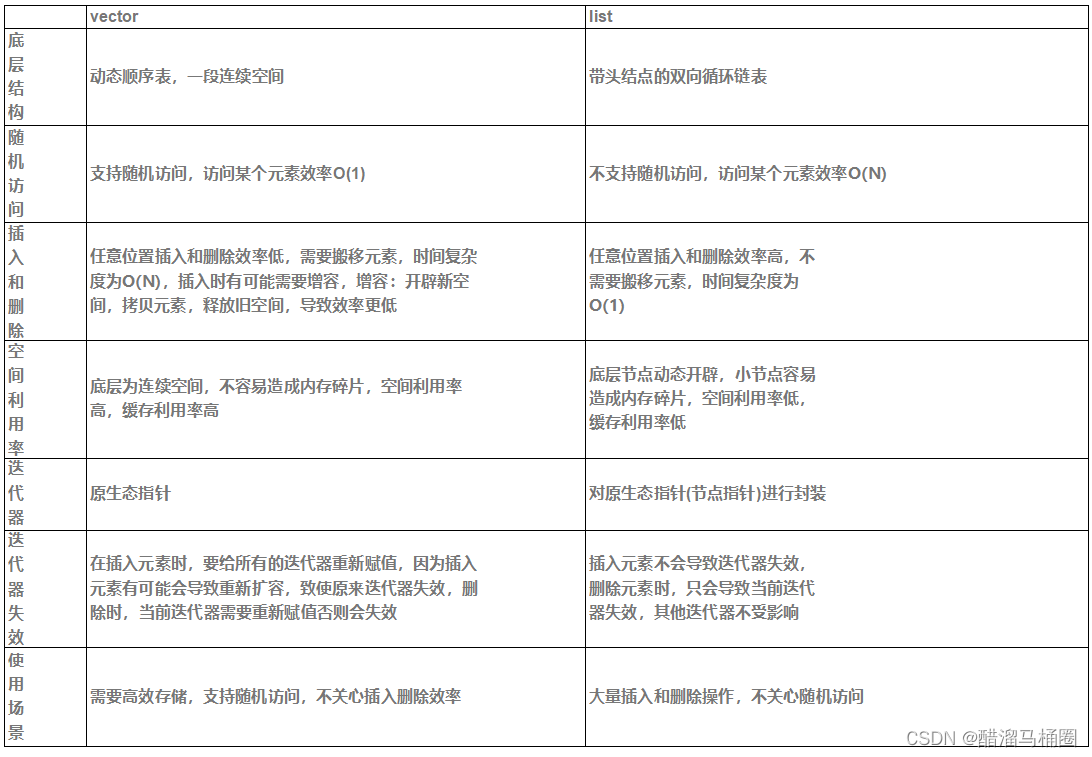
3.2 对比list排序和vector排序
void test2()
{srand(time(0));const int N = 1000000;list<int> lt1;list<int> lt2;vector<int> v;for (int i = 0; i < N; i++){auto e = rand()+i;lt1.push_back(e);v.push_back(e);}int begin1 = clock();//排序sort(v.begin(), v.end());int end1 = clock();int begin2 = clock();lt1.sort();int end2 = clock();printf("vector sort:%d\n", end1 - begin1);printf("list sort:%d\n", end2 - begin2);
}![[Pytorch]:PyTorch中张量乘法大全](/images/no-images.jpg)

